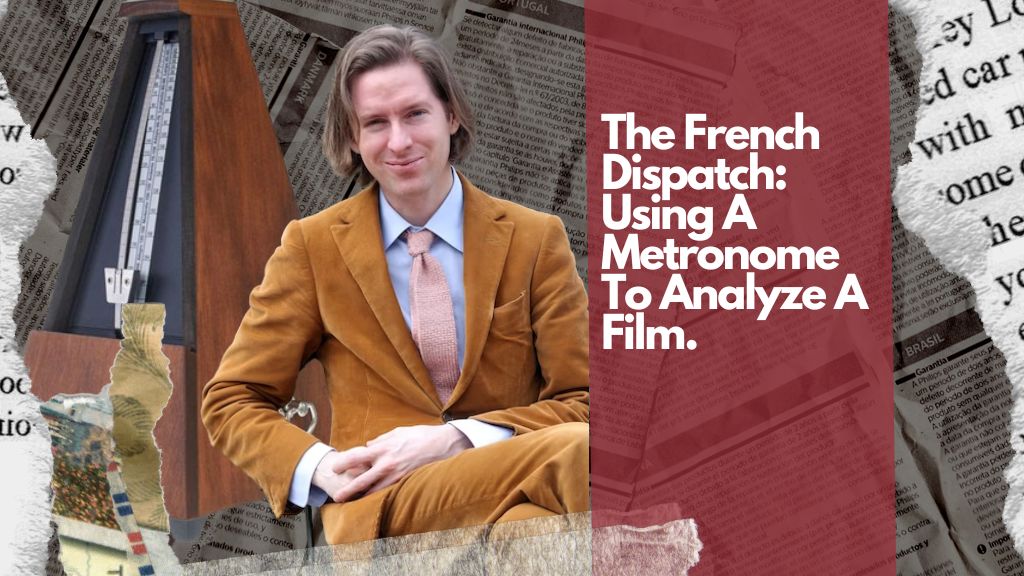
The French Dispatch: Using A Metronome To Analyze A Film
As the opening credits roll for Wes Anderson's latest film, "The French Dispatch," viewers are greeted with a flurry of intricately detailed sets, charmingly quirky characters, and a whimsical sense of humor that can only be attributed to the mind of this celebrated auteur.
The film is set in the fictional French town of Ennui-sur-Blasé, where a small team of journalists work for an American newspaper, The French Dispatch. The publication is overseen by its eccentric editor-in-chief, Arthur Howitzer Jr., played brilliantly by Bill Murray. The movie is divided into three distinct parts, each representing a different story from the paper.
The first segment, titled "The Concrete Masterpiece," follows a jailed artist named Moses Rosenthaler, played by Benicio Del Toro, as he creates a mural inside the prison. The story is narrated by Tilda Swinton's character, J.K.L. Berensen, a writer for The French Dispatch who is known for her dry wit and deadpan delivery. As she explains Rosenthaler's story, Anderson's camera lingers over the various details of the prison, from the crumbling walls to the peeling paint, all brought to life with an impeccable eye for detail.
The second segment, "Revisions to a Manifesto," is a bit more lighthearted, as it follows a student revolution led by a trio of young activists, played by Timothée Chalamet, Léa Seydoux, and Lyna Khoudri. The story is narrated by Frances McDormand's character, Lucinda Krementz, a writer for The French Dispatch who is known for her blunt, matter-of-fact style. As she details the revolution, Anderson employs his trademark visual style, using symmetry, bright colors, and meticulously crafted sets to create a surreal, dreamlike world.
The third and final segment, "The Private Dining Room of the Police Commissioner," is perhaps the most captivating of the three. It tells the story of a chef named Nescaffier who is hired by the police commissioner to cook a meal for a group of wealthy guests. The story is narrated by Jeffrey Wright's character, Roebuck Wright, a food writer for The French Dispatch who is known for his poetic, flowery language. As he describes the meal, Anderson's camera lingers over each dish, highlighting the colors, textures, and flavors in a way that is both sumptuous and tantalizing.
As with all of Anderson's films, the attention to detail in "The French Dispatch" is staggering. From the meticulously crafted sets to the perfectly tailored costumes, every aspect of the movie is designed to create a fully realized world that is both quirky and charming. The performances are also top-notch, with each actor bringing their own unique spin to their character.
Perhaps the most impressive aspect of the movie, however, is the way Anderson weaves together these seemingly disparate stories into a cohesive whole. Each segment is connected by the theme of storytelling, and as the film progresses, we see how the various threads come together to form a larger narrative. It's a testament to Anderson's skill as a filmmaker that he is able to balance so many different elements without losing sight of the bigger picture.
At its core, "The French Dispatch" is a celebration of the power of storytelling. Whether it's the tales of a jailed artist, a student revolution, or a sumptuous meal, each story is imbued with a sense of wonder and whimsy that is both captivating and inspiring. Anderson's unique style may not be for everyone, but for those who appreciate his idiosyncratic approach to filmmaking, "The French Dispatch" is a must-see. It's a film that reminds us of the importance of human connection, and the way that stories can bring us together, even in the most unlikely of circumstances.
Anderson's use of narration throughout the film is also worth noting. Each story is told from the perspective of a different writer for The French Dispatch, each with their own distinct voice and style. By using narration to tie the different segments together, Anderson is able to create a cohesive whole, while still allowing each story to stand on its own.
J.K.L. Berensen's dry, sarcastic tone is the perfect fit for the story of Moses Rosenthaler, highlighting the absurdity of the situation and bringing a touch of humor to an otherwise dark tale. Lucinda Krementz's matter-of-fact style is a great contrast to the more dreamlike qualities of the student revolution segment, grounding the story in a sense of reality. And Roebuck Wright's flowery language is the perfect complement to the sumptuous visuals of the meal in the final segment, elevating the experience to something truly transcendent.
In many ways, "The French Dispatch" feels like the culmination of Anderson's career so far. It takes everything that has made his previous films so beloved - the intricate sets, the quirky characters, the whimsical storytelling - and elevates it to a new level. It's a film that is both deeply personal and universally relatable, and one that is sure to delight fans of Anderson's work and newcomers alike.
Of course, no review of a Wes Anderson film would be complete without discussing the soundtrack. As with his previous films, Anderson has once again curated an eclectic mix of music that perfectly complements the visuals on screen. From Alexandre Desplat's playful score to classic French chansons to a stirring rendition of Bob Dylan's "The Times They Are A-Changin'," the music adds an extra layer of depth and emotion to the already rich and complex world of the film.
In conclusion, "The French Dispatch" is a triumph of filmmaking, a movie that is sure to delight and inspire audiences for years to come. With its charmingly quirky characters, stunning visuals, and whimsical storytelling, it is a film that captures the very essence of what makes Wes Anderson's work so unique and special. Whether you're a die-hard fan or a newcomer to his oeuvre, "The French Dispatch" is a movie that you won't want to miss.
BPM and Practicality
There is a distinctive visual rhythm in the movie as we see several motions in our screen following a certain tempo. Just like jazz improvisation, Anderson introduces us to a complete instrumented movement in 52 BPM.
Several sequences in the latest movie by Wes Anderson follow a metronome running at 52 beats per minute. The French dispatch has a distinct visual rhythm that is not a result of the music. In one scene, there are two unique tracks, neither of which has a pace of 52 BPM, creating a noticeable rhythm that is distinct from the music and dialogue's tempos. In the same scene, we can observe that many edits or significant actions generally follow the metronome's beat. This particular visual rhythm is another illustration of the artistic decision. This was excellently described by Thomas Flight.
What differentiates Anderson's films and makes them special are not the obvious symmetrical shots and special colours. The plot and the way the story progresses is conveyed to the viewer in such a way that there is no doubt about the practicality of events happening while always retaining a childlike poignancy. The scene in which Benicio del Toro receives the medallion of his younger self, who touches him on the back and walks away, marking the end of the years, is characteristic.









